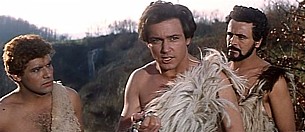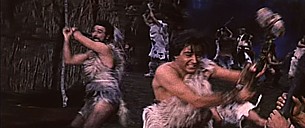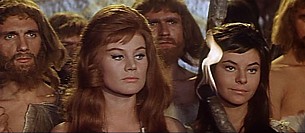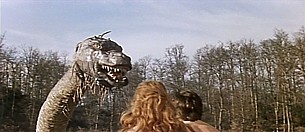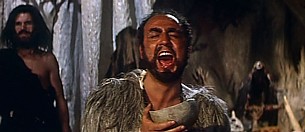Fire Monsters Against The Son Of Hercules/Review
From The Grindhouse Cinema Database
< Fire Monsters Against The Son Of Hercules

Muscles, monsters and maidens populate Guido Malatesta’s 1962 fantasy epic ‘Maciste Contro I Mostri’. Via the magical transformative powers of really bad dialogue dubbing hero Maciste becomes Maxus, Son of Hercules for the benefit of English speaking audiences but whatever name our hero goes by the film is an unbelievably kitsch slice of mythological hokum sure to tantalise (and possibly traumatise) the synapses of any cinephile with a predilection for the peculiar.
A band of nomadic cave-hippies build a village in a valley having been led there by their Sun God (i.e. the sun). What they don’t realise is that the land is already home to another clan of ‘primitive screwheads’ called the Droods (kinda like a cross between dudes and druids but evil) who worship their Moon God (i.e. the moon). Among the Sun Tribe are two young lovers named Rhia and Idar. Rhia is impatient and wants Idar to marry her. ‘I’m 18 and I’ll be old soon’ she says while Idar is trying to fish. Their romantic dialogue is interrupted by the appearance of an enormous sea-serpent but luckily the legendary ginger muscleman Maxus, Son of Hercules, happens to be passing. He’s ripped. He wears a loin cloth. He has a quiff. All things which tell us he’s a hero. Maxus spears the big rubber beast in the eye and sends the young lovers on their way with a cheesy grin and his blessing.
Unfortunately for them Idar and Rhia’s wedding is gate-crashed by the vindictive Drood Tribe who kill the boy’s father and kidnap all the women from the village in order to behead them as sacrificial offerings to the all-powerful Moon God. Of course Maxus returns to lend a hand and leads a sneak attack on Drood HQ. The village ‘virgins’ are successfully rescued amid much manly grappling but Maxus is captured by Fuan, the merciless leader of the moon-cult, after urging Idar to escape with his bride to be. Our hero is buried up to his neck in the ground and, when she tries to help him to get free, so is Fuan’s captive mistress Moa. Quicker than you can say ‘Deus Ex Machina’, that conveniently regular prehistoric movie cliché, an erupting volcano splits the earth asunder freeing Maxus and Moa and prompting an inordinate amount of papier-mache boulders to fall and crush the panicking moon-loons. But the peril doesn’t end there for our muscle-bound man of action; he still has to face off against lumbering lizards, camp cannibals, a grumpy cave-dwelling dragon and some very pissed off Droods!
The Italian ‘peplum’ genre is a peculiar mix of historical epic, gladiatorial spectacle and fairy tale fantasy wherein audiences regularly encounter incongruous iconography mashed together from disparate eras and geographic locations. The heroes of these tales often found themselves renamed depending on where the films were being exhibited, hence Maciste (a popular mythological figure in Italy) becomes offspring of the more widely known Greek hero Hercules in English speaking territories but he could just as easily have found himself becoming a Samson or an Atlas, an Ursus or a Goliath. These interchangeable monikers only go to prove that, for the purposes of this particular cult film sub-genre at least, these legendary characters are by and large a single figurative hero; all are essentially the same muscle bound man of might and morals regardless of their particular provenance.
‘Fire Monsters against the Son of Hercules’ is a particularly kitsch and colourful entry in the peplum genre, packed with big brawls and pec flexing. Maxus/Maciste is the only character who isn’t a member of a primitive clan, appearing to have wandered in from another slightly more civilised movie, and the focus on stone-age tribal conflict means the film has as much in common with the likes of One Million Years BC as it does with more popular pepla such as Pietro Francisci’s Hercules films starring Steve Reeves. The sets and special effects are cheap but ambitious and the sense of scale and spectacle, especially in the frequent well populated battle scenes, is enhanced when the film is viewed in its original 2.35:1 screen ratio. A fair amount of attention has been paid to the costumes too with most of the budget obviously spent on covering the cave men and women in fake fur. During one fight scene however a tribesman trips and reveals that beneath his shaggy animal pelt he is wearing bright red cotton underpants! No doubt for the purposes of scaring off dragons.
Narcan is the GCDb's esteemed UK contributor. As a youth his earliest exploitation film experience was a My Bloody Valentine/The Funhouse midnight double bill. Grindhouse icons that he holds in highest regards are Christina Lindberg and Frank Henelotter. Two of his favorite exploitation genres include Nunsploitation and Lucha Libre.












